Yeshiva University fans prepare to welcome back Ryan Turell for his first G League game in New York — right after Shabbat
(JTA) — Ryan Turell may be from Los Angeles, but when he returns to New York as a member of an NBA G League team on Feb. 4, the game will represent a homecoming of sorts.
Turell, the former Yeshiva University basketball star who in October became the first known Orthodox player to be drafted into the G League, is returning to New York for the first time this season, as his Motor City Cruise — the Detroit Pistons’ minor league affiliate — take on the Long Island Nets at the Nassau Veterans Memorial Coliseum in Uniondale, New York.
The 6-foot-7 forward has drawn a growing crowd of Jewish fans in Detroit as an openly Orthodox player who wears a kippah on the court. But the Feb. 4 game will be the first opportunity for Y.U. fans to see their former star in action since he graduated.
“I don’t think people realize, there’s so many Y.U. fans that have watched Ryan play for four years at Y.U., and now they’re going to have a chance to see him in a G League uniform in New York,” said Simmy Cohen, a Y.U. superfan who works in marketing.
The game will tip off at 7 p.m. Saturday night, an hour after Shabbat will end. That wasn’t always the plan: Brad Turell, Ryan’s father, told the Jewish Telegraphic Agency that the matchup was originally scheduled for 11 a.m. — which would present a challenge for those who do not travel on Shabbat. He and another observant fan both contacted the Nets about the conflict.
“We just told the Nets, hey, by the way, you have Ryan Turell, it’s his return to New York, a lot of Jews from Long Island and the surrounding area would love to attend, if you made the game after sundown,” Brad Turell said.
Within 24 hours, the game was moved to 7 p.m.
“They got it. They understood it, they didn’t question it, they didn’t say there’s red tape,” Brad Turell said.
Brad Turell, a communications executive at a Los Angeles talent agency, said he and his family have been to seven of Ryan’s games in Detroit, plus the three recent matchups in Los Angeles. He said he “wouldn’t miss” the game in New York.
Cohen, who grew up near the Nets arena on Long Island, also said he will be at the Feb. 4 game. He anticipates that quite a few of his fellow Y.U. Maccabees fans will be there, too.
“I’m predicting that it’s going to be really, really wild,” Cohen said. “And it’s interesting, because he’s playing for the road team. A lot of the fans coming to the game are going to be chanting for him, wearing blonde wigs or wearing his shirts, and screaming for one specific opposing player who’s on the bench more than he’s on the floor. And chanting ‘We want Ryan!’ I’m going to be leading that if no one else will.”
Brad Turell said his son’s return to New York could be “emotional and cathartic” for Y.U. fans — and that some singing may even break out in the stands, as is customary at Maccabees games. (Another aspect of the celebration: Feb. 4 is the day after Turell’s 24th birthday.)
The wigs Cohen referenced are just one way Turell fans have shown their support for the golden-haired prospect: There are Turell-branded shirts — including a special one for the Feb. 4 game that is no longer available — plus branded kippahs, sweatshirts and hats for sale on his website.
Cohen, a self-described “extremely online fan of Jews in sports,” said he started following Turell a few years ago, during the Maccabees’ unlikely 50-game winning streak.
“I was really interested in their success and jumped on the bandwagon when they were winning a billion games in a row and having so much success and kind of taking DIII by surprise,” Cohen said. “And how the Jewish community was rallying behind them, I got into that.”
For Brad Turell, Jewish fans’ embrace of his son has been “the most satisfying aspect of this entire journey,” he said.
“They’re proud that this guy — who wears a yarmulke and proudly represents Yeshiva University and the Jewish people — is getting his shot, and that all the hype that surrounded Ryan in college, which was quite phenomenal, was real,” Brad Turell said. “He is good. The fact is, you can’t play in the G League unless you are really good.”

Ryan Turell wears a kippah when he plays. (Courtesy Motor City Cruise)
Ryan Turell told JTA at a November game in Detroit that he appreciates all of the Jewish fan support. “Jews love basketball. They really do,” he said. “The Jewish community is incredible, them coming out and cheering me on. It really means the world to me. And it’s special, because it’s bigger than basketball.”
Turell has appeared in 27 of the Cruise’s 30 games between the preseason Showcase Cup and regular season this year, playing off the bench. He’s averaging 14.3 minutes during the regular season (out of 48 in each game), with 4.2 points per game.
Turell’s best performance of the regular season was his first: he scored 21 points in less than 18 minutes on Dec. 27.
“He’s the perfect guy to have this happen to,” Cohen said. “He’s just such a mensch, on and off the court. Cheering on his teammates, helping people up when they fall down, things like that.”
But for Cohen, Turell’s appeal transcends his ability to sink three-pointers.
“He’s always talking about and thanking Hashem [God], and he’s talking about being a Jewish hero and a Jewish role model,” Cohen said.
For fans who can’t make it on Feb. 4, the Cruise will be back in Long Island in March — on Purim. Cohen pointed out that the timing of the game, 11 a.m., may be auspicious for those who observe the holiday.
“After you hear megillah and before you have your seudah [the festive Purim afternoon meal], what else are people doing in that in-between time on Purim?” Cohen said. “It could be something that kind of bridges the gap of the day.”
Brad Turell said the timing of the March 7 game is perfect — perhaps even divine.
“If you didn’t think Hashem was looking down upon this situation and helping this out, you look at that and say [Ryan] is going to be in Long Island at 11 a.m. on Purim day. How does that happen?” he said. “A day when all the kids are off school, where everyone’s in a great mood. This is a great family activity, and it’s an 11 a.m. game. It’s just fantastic.”
We’re visiting Auschwitz because the fight against antisemitism didn’t end with liberation
(JTA) — Today, we will visit Auschwitz-Birkenau to mark International Holocaust Remembrance Day. We will represent the United States and honor the lives of 6 million Jews and millions of others murdered. While at Auschwitz, we will also express gratitude to the survivors and speak of the lessons learned in that era of terror.
As we reflect on history, we know that the bigotry that fueled the Holocaust did not end when the camps were liberated. Antisemitism may be considered one of the oldest forms of hatred, but its insidious impact and its deep dangers are not relegated to the past.
Antisemitism is increasing at home and abroad. Hatred of Jewish people simply for being Jews is real and rising. We can only stop this scourge if governments and community leaders declare it unacceptable and inconsistent with our values.
With that in mind, we will convene community leaders in Poland to discuss efforts underway to combat antisemitism. Then, we will travel to Berlin, where we will meet with foreign government officials, who are also dedicated to turning the tide of hate. Our goal is to deepen our relationships with European partners — in and out of government — to combat the rise in antisemitism.
We can learn from each other and share our best practices. We can lead through our shared values of equality, diversity, and human rights. This moment calls on us to take action, together, based on these values.
It’s too often that we hear stories about attacks on Jewish communities. We see vandalism, threats, and violent, hateful rhetoric. People used to be afraid to say the ugly epithets and lies out loud. Now they are literally screaming them.
Related: Explore Emhoff and Lipstadt’s entire itinerary for their Poland and Germany trip
In 2018, a horrific antisemitic assault stole the lives of 11 innocent people at the Tree of Life synagogue. In 2019, a gunman opened fire at California’s Chabad of Poway, killing one and wounding three more people in an attack motivated by antisemitism. And just last year, in Los Angeles, we saw antisemitic banners hung over a freeway.
Heinous and senseless acts of violence bring pain to the Jewish community. We’ve heard from parents who are worried about sending their children to preschool at their Jewish community center because they fear for their safety. They must explain to their children why the synagogue they attend has an armed guard at the entrance while the church across the street has none.
In December, we both attended a roundtable at the White House convening Jewish leaders in the United States. We spoke about the impact antisemitism is having on their communities including issues of safety, education, and accountability. Under the leadership of President Joe Biden and Vice President Kamala Harris, we have increased funding for physical security of nonprofits and synagogues, and appointed leaders to focus on hate crimes and track and fight antisemitism.
Through a whole-of-government approach, the Biden-Harris Administration is crafting a broad-based national plan to address antisemitism. The first mandate of the interagency is to create a U.S. National Action Plan on Antisemitism.
But we know there is more work to be done. We each need to do our part to educate those around us and instill knowledge in the next generation of leaders to help fight antisemitism. We cannot and will not allow this to be normalized and politicized. We all have a responsibility to speak out and make clear that antisemitism is wrong, just like every other prejudice. We must all condemn antisemites as dangerous and also call out those who don’t. In the face of evil, there is no neutrality. Standing silent is not an option. Indeed, silence is what allows vile oppressors to thrive and this malicious virus of hate to grow.
It is time — yet again — for us to replace the silence, of the past and present, with a chorus of voices making antisemitism a relic and this horrific hatred a thing of the past.
A new portrait collection showcases 90 Holocaust survivors who lived long and full lives
(JTA) — Werner Reich had his opening line ready when he sat down for B.A. Van Sise to take his portrait.
“Before I could say anything, he said, ‘Everybody comes to me and they want me to talk about the Holocaust. What am I supposed to say? I went to Auschwitz. It was lousy,’” Van Sise said, recalling that Reich’s comment felt like a joke, not a lament.
But instead of dwelling on the horrors of the Nazi concentration camp, the two men spoke about magic, a refuge for Reich as a Jewish teenager trying to survive. The resulting portrait shows a man in his 90s wearing retro glasses, a cloud of smoke floating a few inches above his open palm, in a picture vibrating with life and with enchantment.
Van Sise’s portrait of Reich is the first in “Invited to Life: Finding Hope After the Holocaust,” his new portrait collection of 90 Holocaust survivors. The accompanying text acknowledges Reich’s experience at Auschwitz, but it focuses more on Reich’s life after the war and his long career in magic — striking a balance that Van Sise says is core to his project.
“This is not something that people are inclined to talk about because it’s not always bombastic. It’s not the part that you sell movie tickets to,” Van Sise said. “You can make, and people have, a hundred movies about Jewish people being imprisoned, tortured, and enslaved. Why doesn’t anybody talk about them thriving afterwards?”
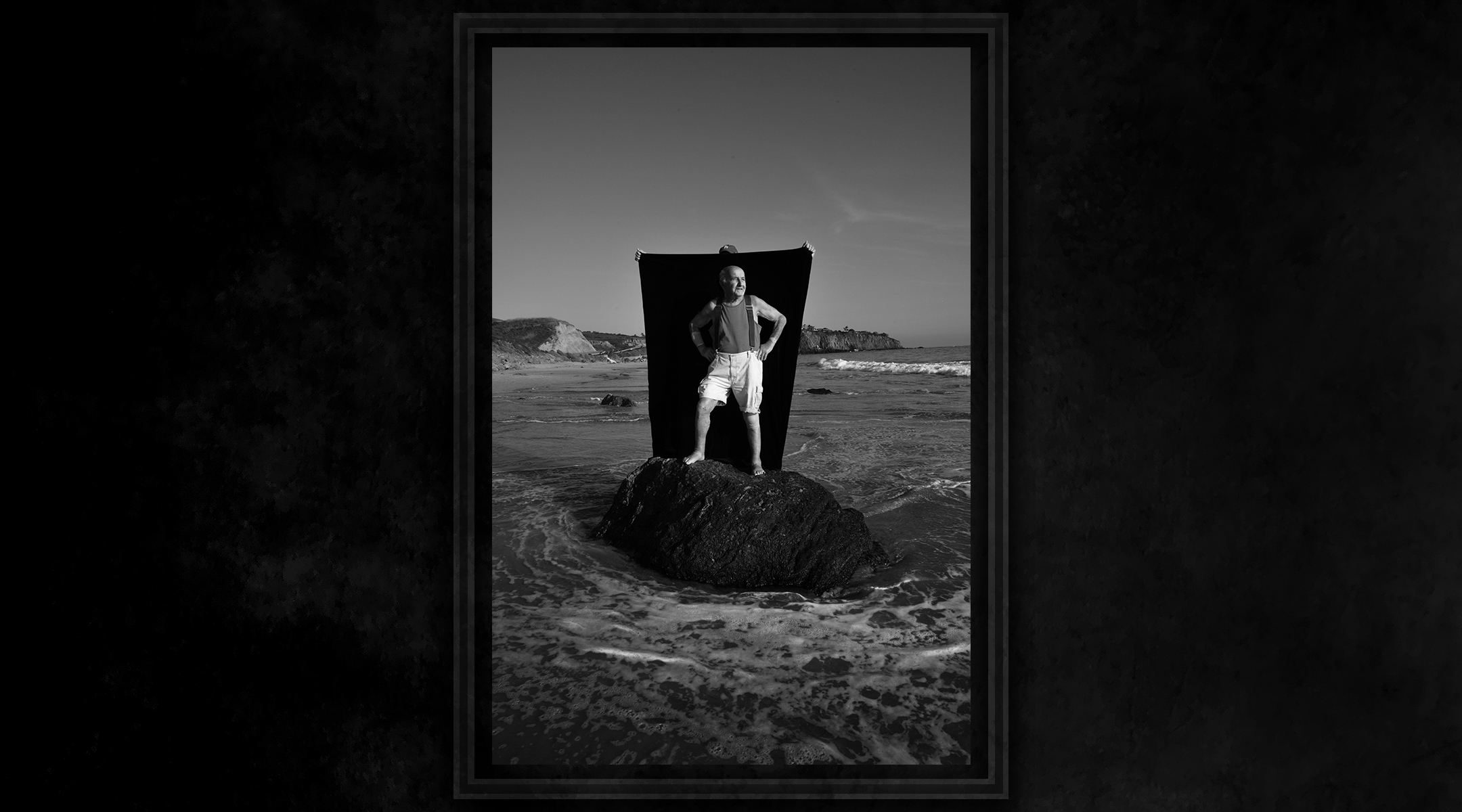
Holocaust survivor and hiking enthusiast Sam Silberberg poses for “Invited to Life”. (Courtesy of B.A. Van Sise / Design by Grace Yagel)
Van Sise is far from the first photographer to capture the faces of survivors in the decades following the end of the Second World War. Famed portrait photographers Martin Schoeller and Mark Seliger, both known for their iconic celebrity portraiture — Schoeller for his uniform, stylized close-ups and Seliger as a magazine photographer who also recently photographed Jerry Seinfeld in a fashion shoot — have also set their cameras in front of Holocaust survivors. Countless other photographers have done the same. But what Van Sise says is sometimes missing from survivor photography is a focus on the postwar lives, many of them joyous, that the subjects have experienced over the last 70-plus years.
“I suspect that one person might see these folks and see victims,” Van Sise said. “And I see them as survivors.”
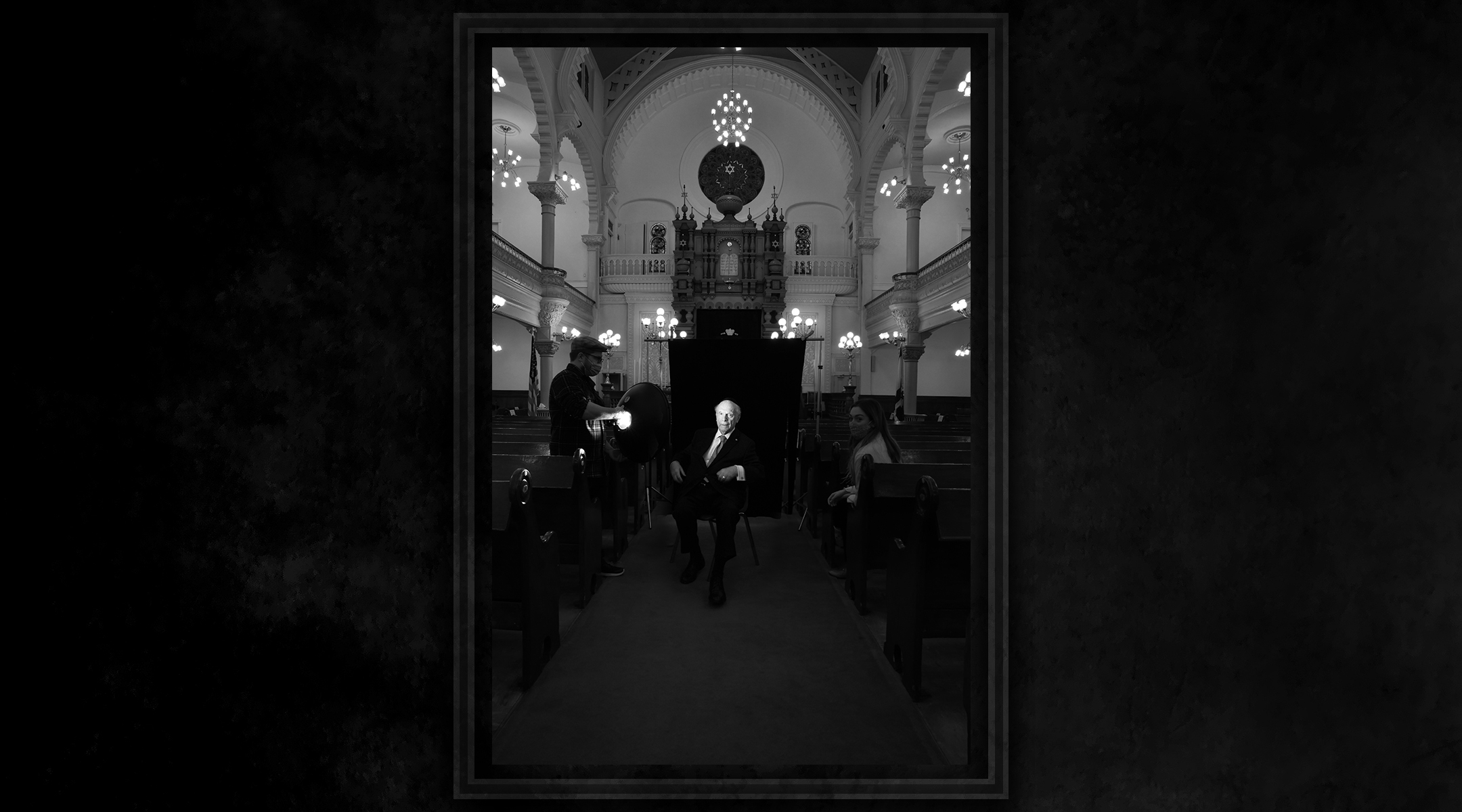
Holocaust survivor and Park East Synagogue Rabbi Arthur Schneier poses for “Invited to Life”. (Courtesy of B.A. Van Sise / Design by Grace Yagel)
“Invited to Life” was inspired by a 2015 photo assignment Van Sise took on for the Village Voice. Motivated by the anti-immigrant, anti-refugee rhetoric of then-candidate for president Donald Trump, he realized that a particularly cohesive cohort of refugees to come to the United States had arrived more than 75 years ago, at the end of the Second World War, and a photographic retrospective on their lives in America could be a valuable project. He reached out to the Museum of Jewish Heritage in New York to be put in touch with a dozen survivors for the story. He ended up taking more than 30 portraits. When the alternative newsweekly ceased publication in 2017 (it was revived in 2021) before he could publish the photos, the museum invited Van Sise to turn the portraits into a solo exhibition, in what became the museum’s first-ever public art installation.
Then the pandemic arrived, and like many photographers whose everyday work required travel, Van Sise was out of a job.
“It had never been a marquee project for me,” said Van Sise, who is Jewish but has no familial connection to the Holocaust. “I kept coming back and thinking about them, and about the fact that these people had been through the worst there ever was, the worst that ever has been, the worst there ever might even be.”
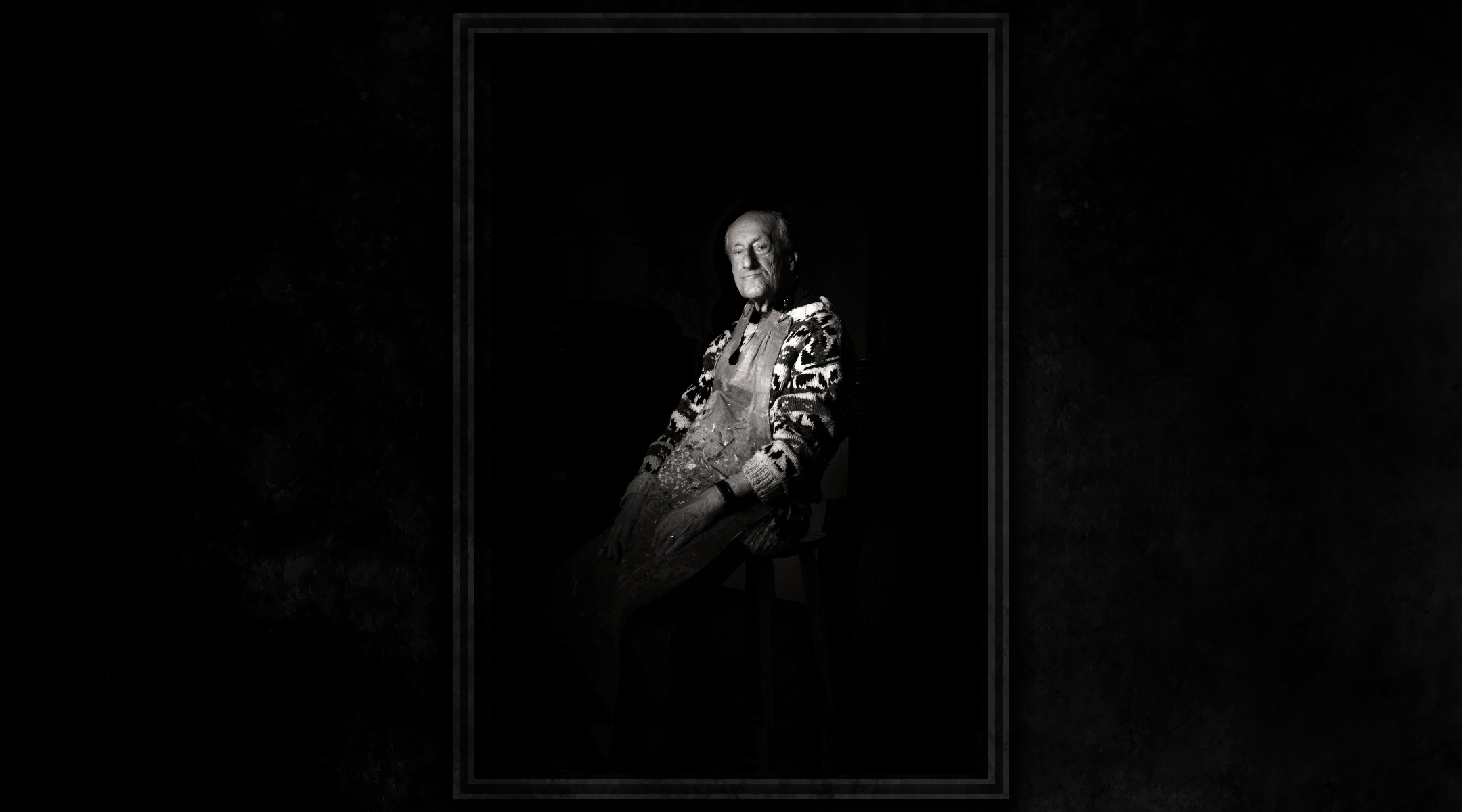
Holocaust survivor and painter Fred Terna poses for “Invited to Life”. (Courtesy of B.A. Van Sise / Design by Grace Yagel)
Van Sise spent the better part of 2020 driving around the United States, getting COVID swabs every three days so he could safely photograph 140 elderly survivors, 90 of whom ended up in the book. (He was insistent with his publisher that the final number of portraits in the book be a multiple of 18, the Jewish numerical symbol for “life”.)
The photos are all in black and white, but beyond that, they are as diverse as Van Sise’s subjects. Some incorporate backgrounds, some are solo portraits; some are serious, some are silly; some include children, grandchildren, husbands, wives, props; some are in profile, and some are shot straight on. The subjects are Nobel Prize-winning chemists and homemakers; pilots and psychologists; haberdashers and teachers; famed rabbis and partisans-turned-conmen.
All of them, Van Sise says, were photographed with a sense of generosity.
“A person who wants to be critical of me — which is fair — might say that I’m overly charitable,” Van Sise says of his own work, acknowledging that no photographer can avoid bias completely while behind the camera. (It didn’t help that many of the survivors he photographed were eager to feed him cookies, as he frequently recalls.)
In the nearly three years since Van Sise began photographing the subjects of his book, the reality of working with more than 100 elderly people set in. Several of the survivors, including Holocaust educator René Slotkin, Budapest-born legal secretary Kathy Griesz and Reich died before they got the chance to hold a copy of the book in their hands, much to Van Sise’s dismay.
“As a writer, you carry them with you,” he said. “So for me, there were a few where I got pretty rattled.”
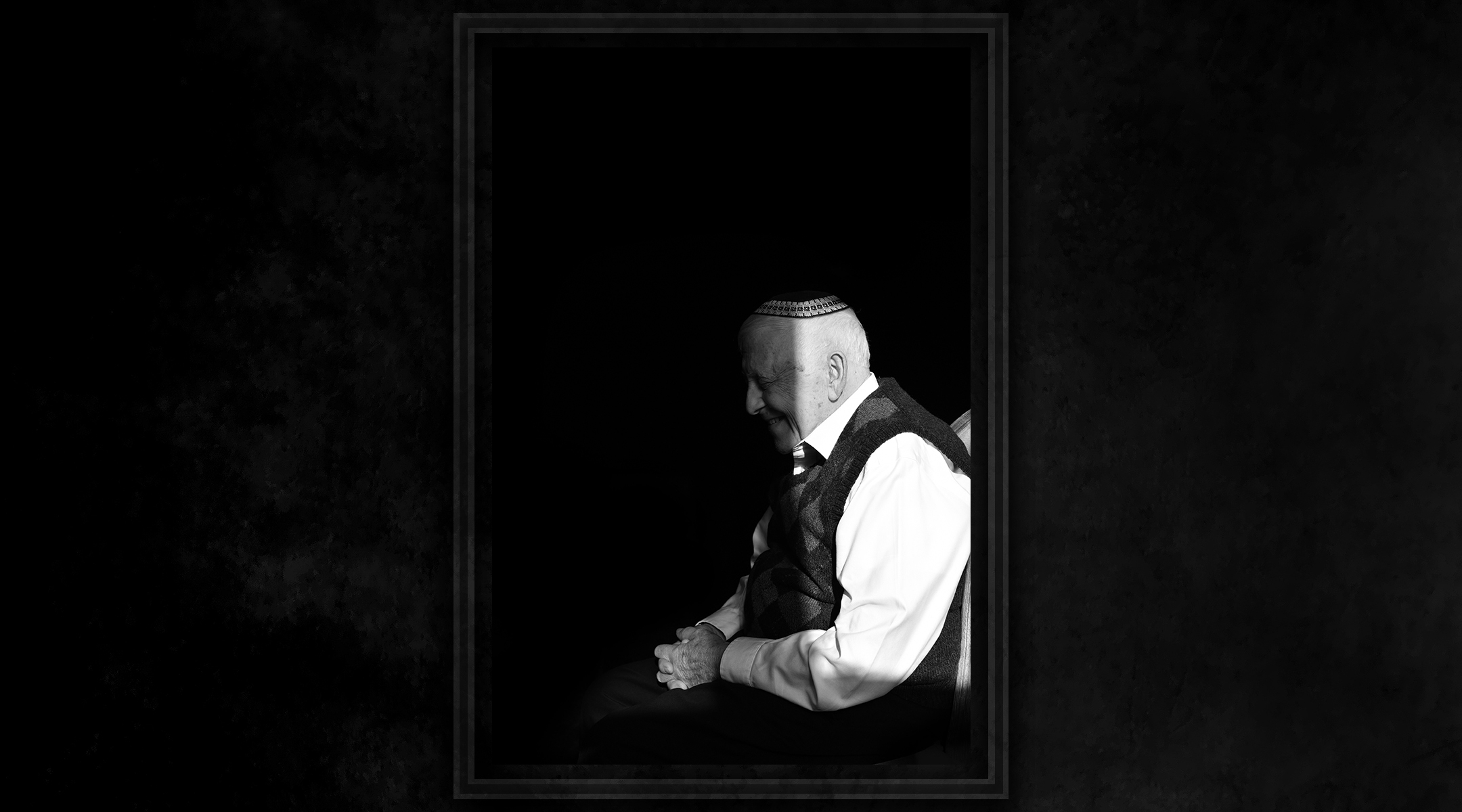
Holocaust survivor and educator René Slotkin poses for “Invited to Life”. (Courtesy of B.A. Van Sise / Design by Grace Yagel)
The photographs reflect acknowledgment by all involved that the survivors in the pictures are all nearing the ends of their lives. Many of his subjects chose to include their children, grandchildren, or great-grandchildren in their portraits, and the photographer was intentional in closing the book with a portrait of Irving Roth, a longtime Holocaust educator, with his 3-year-old great-granddaughter Addie sitting on his lap. In the text, Roth remarks on the origins of his Hebrew name, Shmuel Meir, which came from his great-grandfather and imagines what life will be like for Addie when she turns 103, and what she will remember of him.
Roth passed away in February 2021 at age 91.
“Those stories don’t end in 1945,” Van Sise said. “These people have lived for, now, 77 years since and have done plenty with that time. And that’s worth exploring, because that’s the part they have control over.”
Reflecting on different styles of Holocaust survivor portraiture at a discussion at the Museum of Jewish Heritage, the original home of Van Sise’s portraits, German photographer Martin Schoeller remarked on his own preference for images of older faces.
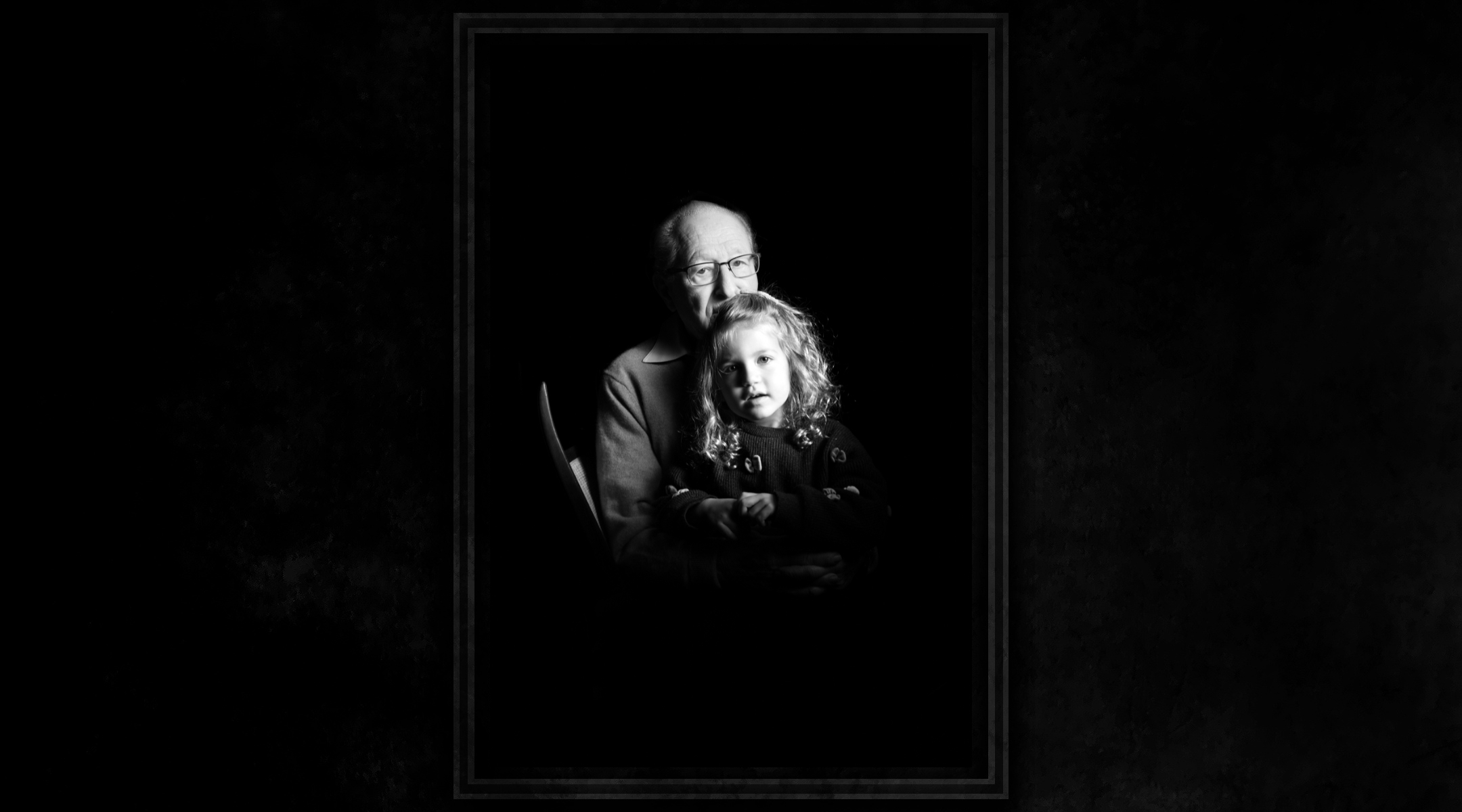
Holocaust survivor and educator Irving Roth and great-granddaughter Addie pose together for “Invited to Life”. (Courtesy of B.A. Van Sise / Design by Grace Yagel)
“They have more life in them. You see the wrinkles and you feel that there’s more to discover in the face, in an old face. So they almost feel like they’re telling the story of the suffering of the Holocaust more visually, because they’re older faces,” Schoeller said.
“But then, it’s been 75 years since the end of the war,” he added. “So these people have lived 75 years; so to say, ‘Now I see the horror in this old man’s face’ feels a little bit — I don’t know if that’s really true. I leave it up to the people looking at the pictures.”
A New York celebration of Ladino aims to demonstrate that the Judeo-Spanish language is very much alive
(New York Jewish Week) — The sixth annual New York Ladino Day — which aims to celebrate and elevate Ladino culture in New York and throughout the world — will take place this Sunday at the Center for Jewish History in Manhattan.
For the first time since the pandemic, the program will be conducted in person, though a livestream option is also available. This year’s theme is “Kontar i Kantar” — “Storytelling and Singing” — and will include a performance from Tony- and Grammy-nominated Broadway singer Shoshana Bean and a conversation with Michael Frank, author of “One Hundred Saturdays: Stella Levi and the Search for a Lost World,” as well as additional music-oriented speakers and performances.
“Music is certainly one of the domains in which the language is doing well and generating new interest and new music,” said Bryan Kirschen, a professor of Hispanic Linguistics at Binghamton University and one of the event’s organizers. (Kirschen was one of the New York Jewish Week’s “36 Under 36” in 2017.)
Ladino, or Judeo-Spanish refers to the language spoken by Jews who trace their origins to the Iberian Peninsula. After the Jews’ expulsion in 1492, they preserved elements of their language while also incorporating new linguistic features and vocabulary into it as they settled throughout the Ottoman Empire — Turkey, North Africa and the Balkans. Today, the estimated number of Ladino speakers around the world — mostly Sephardic Jews — ranges between 60,000 to 300,000, from fluent speakers to descendants who are familiar with some words.
Sephardic Jews were the first Jewish immigrants in New York, founding Congregation Shearith Israel in 1654, the oldest Jewish congregation in the United States. (It’s still in operation today at 2 West 70th St., where it has been since 1897.) Sephardic Jews remained the only active Jewish community in New York until the wave of German Jewish immigration in the early 19th century, followed by the mass immigration of Eastern European Jews that began at the tail-end of the 19th century.
Soon enough, Ashkenazi Jews quickly outnumbered New York’s Sephardic community, though Sephardic and Ladino culture continues to thrive today. Today, the main hubs for Sephardic and Ladino culture and education are the American Sephardi Federation and the Sephardic Jewish Brotherhood of America, with a range of programming also happening at synagogues like the Kehila Kedosha Janina Synagogue and Museum, The Sephardic Jewish Center of Forest Hills and the Sephardic Jewish Center of Canarsie.
Ladino, said Kirschen, remains “a very living, in some ways thriving language, interestingly enough, particularly since the pandemic.”
Ahead of Sunday’s celebration — which is co-curated by Jane Mushabac, a professor emerita of English at City University of New York and a Ladino scholar and writer — the New York Jewish Week caught up with Kirschen to discuss the program, his personal interest in Ladino, and how Ashkenazi Jews can help uplift Ladino language and culture.
This interview has been lightly edited for length and clarity.
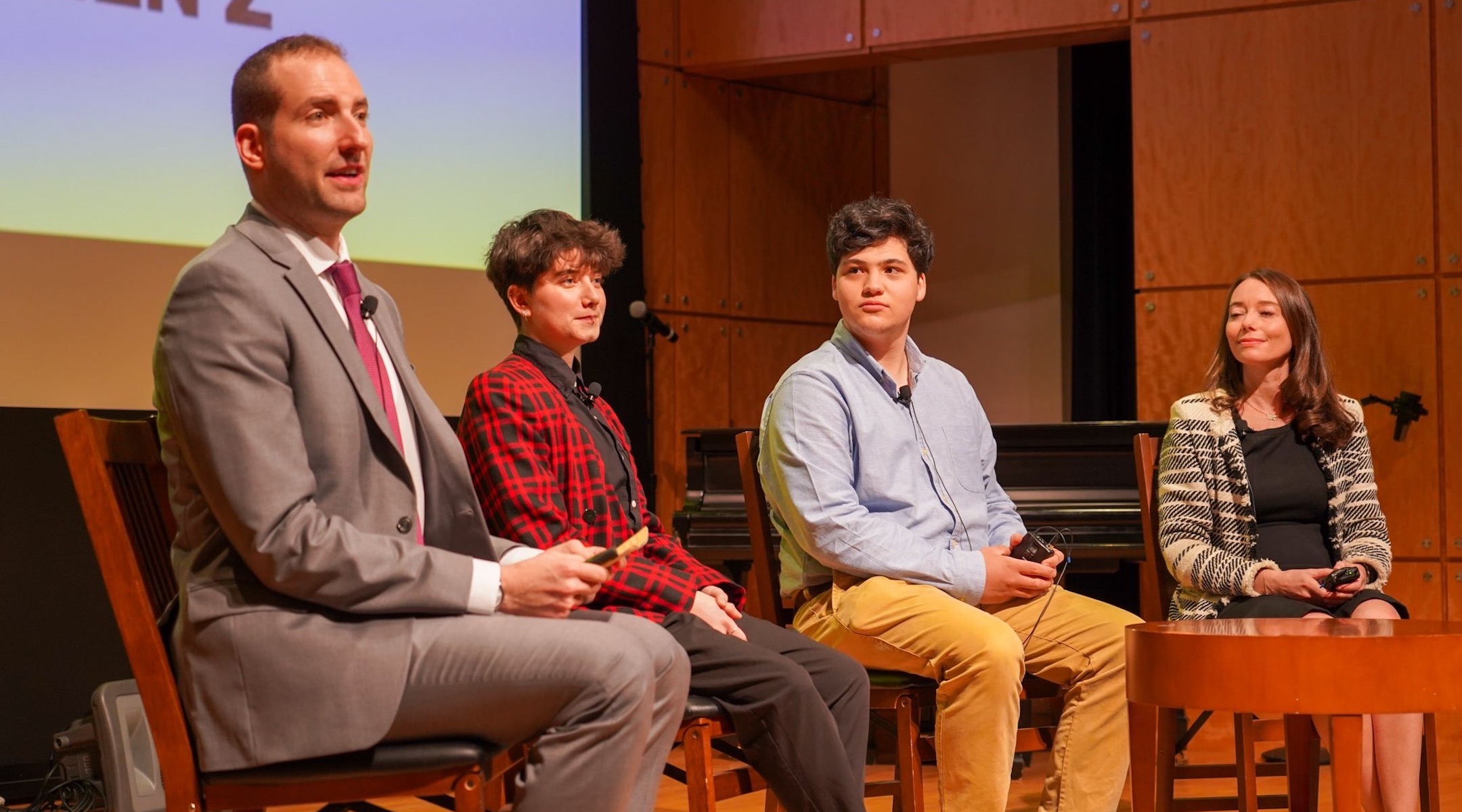
Kirschen, far left, leads a panel discussion during the 2020 New York Ladino Day celebration. (Courtesy Bryan Kirschen)
New York Jewish Week: How did you become interested in Ladino culture? Are you from a Sephardic family?
I’m from an Ashkenazi, Yiddish-oriented family; I’m not Sephardic. But for the past 15 years or so, I’ve been doing my best to learn as much about Sephardic culture as I can, and learn as much as I can about Ladino as well. My own interest stems from learning languages — I’m a Spanish professor at Binghamton University and I have also studied Hebrew for numerous years. When I first came across Ladino, it interested me for a number of reasons. Once I started to meet actual speakers, it became so much more than just the language — it became about celebrating and promoting the culture, the history, the connections, of course the food and the music.
What is the origin story of New York Ladino Day?
The idea of Ladino Day came about in 2013 — to have a day when communities around the world would celebrate all that remains. Originally, the day was selected to be during Hanukkah. But because there is no real central organization that governs the language — though there are different institutions, particularly in Israel, that try to foster the language and help promote it — Ladino Day grew in many different directions.
These days, some communities celebrate in January, some in February, some still in December. The National Authority of Ladino in Israel has their own International Day of Ladino in March. But the important thing is that communities all around the world are committed to celebrating it in their own ways.
As far as New York goes, the American Sephardi Federation at the Center for Jewish History in Manhattan started holding a Ladino Day six years ago under the direction of my collaborator, Jane Mushabac, who is Sephardic from a Ladino-speaking family. I had been separately organizing Judeo-Spanish celebrations with the Sephardic Jewish Brotherhood of America at The Sephardic Jewish Center of Forest Hills, so the following year we joined forces and started co-curating the program together and have been doing that ever since.
The theme for this year’s program is “Kontar i Kantar.” How is this year’s theme different from years’ past?
Last year, our theme was “Salud i Vida, which is a common expression for “health and life” and which was fitting for the time. Like most of the world, we had to pivot for the last two years and hold the program online. That afforded different opportunities — we were able to bring in speakers from around the world in a way that was much more doable, and we were able to open up our program to the world. Normally, we like to focus on New York talent and language, but the previous few years doing online events we were featuring different voices from the Sephardic world, so many new connections were made.
Because of that experience, this year’s program will be back in person at the Center for Jewish History, but with a hybrid option. The theme is “Kontar i Kantar,” “Storytelling and Singing.” It will both acknowledge how important music has been to Ladino, and celebrate how, in recent years, there have been so many initiatives for people to get together to share their stories in or about Ladino and to sing in the language.
Most Jews in New York have an Ashkenazi background. What role or responsibility do you think Ashkenazi Jews have in honoring and preserving Ladino culture?
Yes, the numbers [of Ashkenazi versus Sephardi Jews] don’t match up. Still, Sephardim from Turkey and areas of the former Ottoman Empire brought tens of thousands of Sephardic, Ladino-speaking Jews to New York City at the start of the 20th century, but as a minority — as a minority within the Jews, as a minority-speaking language, etc. So as someone who is Ashkenazi, I understand the enormous responsibility that I have to represent this language in a positive and genuine way to others and to work with and uplift speakers of Ladino.
Like Yiddish, entire communities of Ladino speakers were killed in the Holocaust, and those who didn’t experience the same fate often gave up their Ladino to assimilate. So many speakers today, who are typically in their 70s, 80s or 90s — or maybe younger generations who know some words here and there like foods, terms of kin — haven’t historically been so proud of using their Ladino. Aside from research and teaching, I’m really passionate about encouraging speakers and semi-speakers to use their language and to take pride in Ladino and ideally, give them a platform to do so.
Bonus question: What are some common misconceptions about Ladino?
Ladino is a living language — that’s something I’m very vocal about. There are all sorts of ways to classify and categorize languages, but as long as there are living, breathing, speakers and semi-speakers, the language is living. So despite all the obstacles, Ladino is a living language. There are speakers willing to share their language and their story with people, and there are amazing resources out there, both in person and online.
“Kontar i Kantar: The 6th Annual New York Ladino Day” will take place at the Center for Jewish History (15 West 16th St.) on Sunday at 2:00 p.m. A livestream option is available. Buy tickets and find more information here.
Adam Schiff declares Senate bid, paving way for potential continued Jewish representation from California
WASHINGTON (JTA) — One Jewish Democrat wants to replace a fellow Jewish Democrat as California senator.
Rep. Adam Schiff, who rose to prominence during Donald Trump’s presidency as one of the top critics of the former president, announced a Senate run on Thursday. Sen. Dianne Feinstein, who is 89 and was first elected to the seat in 1992, has yet to announce she is retiring, but insiders say it is increasingly difficult for her to handle the job.
Schiff, a solid pro-Israel Democrat who gets consistent backing from mainstream pro-Israel political action committees, led the first set of impeachment proceedings against Trump. As the focus of Trump’s ire, the former president bestowed on Schiff a number of insulting nicknames, some unprintable. One of them, “Shifty Schiff,” drew accusations that Trump was peddling an antisemitic trope.
Schiff, 62, took aim at Trump in a statement announcing his run.
“We’re in the fight of our lives for the future of our country,” Schiff said. “Our democracy is under assault from MAGA extremists, who care only about gaining power and keeping it. And our economy is simply not working for millions of Americans, who are working harder than ever just to get by.”
Another California Democrat in the House of Representatives, progressive Katie Porter, has also declared for the 2024 Senate race. Like Porter, Schiff says that a Senate run requires time, and that he cannot afford to wait until Feinstein makes her decision.
“We need to start preparing for the fights ahead right now,” Schiff, a formidable fundraiser who has deep ties among Jewish and pro-Israel donors, said in a donor email after his announcement.
Schiff is well known in his Los Angeles district for championing the cause of Armenians and their quest to have the 1915 massacres in Turkey labeled a genocide. His district has a substantial Armenian-American population, but he once explained another motive, having to do with his support for Israel. “I know what it’s like to be part of a people with affinity for a distant country,” he once told an Armenian-American newspaper.
Schiff was until recent weeks the top Democrat on the House Intelligence Committee. As chairman of the committee from 2019 through 2022, he led some of the most damaging investigations of Trump. He succeeded in impeaching Trump in the House for the former president’s efforts to get Ukraine to investigate Biden in exchange for defense assistance. (The Senate would then acquit Trump.)
The new House speaker, Kevin McCarthy, this week used his privilege to block Schiff and another prominent anti-Trump Democrat, California’s Eric Swalwell, from rejoining the committee.
After serving as mayor of San Francisco, Feinstein became the country’s first Jewish woman in the Senate in 1992. Once a reliable centrist pro-Israel voice, she became a critic of some of Israel’s military tactics in the 2000s.
Advocates for Netanyahu’s judicial reforms are increasingly pressing their case in English
(JTA) — The video gives a “Schoolhouse Rock” vibe: Cartoon figures climb the names of the three branches of the U.S. government — “legislature” at the base, “judiciary” at the top and “executive” sandwiched in the middle — as part of a lesson on governance.
But while the video is in English, the government it refers to is not American but Israeli. And the video was produced not by an educational television company but by the Kohelet Policy Forum, a think tank that is widely understood to have influenced the rightward shift within Israeli politics.
The video’s release on Twitter Wednesday appears to be part of a wave of efforts to sell one particularly controversial aspect of that shift — proposed reforms to Israel’s judiciary — to skeptical English speakers. While the many critics of the proposed changes say they would bring Israel out of line with other democracies, all of the English-language efforts press the case that the opposite is true.
“The reforms in progress will address the anomalies of the Israeli system and bring Israel just a few steps closer to the rest of the Western democracies,” concludes the Kohelet Forum video, which features a caped jurist superhero.
Israeli Prime Minister Benjamin Netanyahu has forcefully defended the proposed changes, which include allowing the parliament to overrule the Supreme Court and would have the added benefit of insulating himself from his ongoing corruption prosecution. But he appears to have underestimated opposition to the reforms, which has come not just from liberal Israelis and American Jews but from traditionally nonpartisan think tanks, legal scholars and even right-leaning Americans.
Unlike some of the other changes called for by members of Netanyahu’s governing coalition, which includes far-right extremists and religious parties, the judicial changes are raising questions about core values held by most pro-Israel American conservatives: that Israel is a democratic oasis in the Middle East and that business savvy is an Israeli strength. Foreign investors and international credit agencies have both signaled that if the reforms go through, they will downgrade their estimation of the country.
“The conservative right was with [Netanyahu] and now he seems to be riding the tiger of the radical right,” David Makovsky, a fellow at the Washington Institute for Near East Policy, said in December on the day the government was sworn in, before it had begun turning its ideas into policy proposals. “And I think that is bound to alienate the very people who counted on him being risk-averse and to focus on the economy.”
In a notable symbol of this shift, Bret Stephens, the New York Times columnist who has been a staunch defender of Netanyahu, publicly broke with him on Wednesday, writing that the judicial reforms convinced him that the prime minister had “moved along the current of illiberal democracy whose other champions include Hungary’s Viktor Orban and Brazil’s Jair Bolsonaro.” Meanwhile, Alan Dershowitz, the constitutional lawyer who is usually a stalwart supporter of Israel, has also criticized the reforms.
“It’s a high bar for conservatives in contemporary American politics to criticize Israel, but there have been some cracks,” said Scott Lasensky, who teaches on U.S.-Israel relations at the University of Maryland.
Whether the English-language defenses emanate from any kind of coordinated public relations strategy is unclear. But Lasensky said Netanyahu may feel that he needs to explain why he is dismantling the judiciary to American conservatives, who cherish a judicial system independent of the pressures of successive liberal Democratic administrations.
“American conservatives have a majority on their courts — they don’t want to change their courts,” he said.
It’s unlikely that the Kohelet video will reach an audience anywhere the size that Stephens has. But another defense of the judicial reforms released this week certainly can: that made by Ben Shapiro, the American Jewish right-wing pundit with more than 20 million followers across platforms, on his Daily Wire podcast, which says it has more than 1 million paid subscribers.
“They want the judges of the Supreme Court to be appointed by the prime minister and approved by the Knesset, which sounds like the system in the United States,” Shapiro said in the segment. “They want to ensure, because Israel does not have a constitution, that the Supreme Court will not be able to come up with a constitution in a move of judicial dictatorship. … It’s ridiculous.”
Netanyahu briefly shared a video of Shapiro’s comments on Twitter before his tweet was removed. The version that Netanyahu shared features Hebrew subtitles as well as a message from the person who made it suggesting that Shapiro — who spoke in Israel for the first time last summer — can convince Israelis and Americans alike: “Ben Shapiro supports the judicial reform and not just that he explains why. Watch and join in.”
In yet another English-language defense of the proposed judicial reforms, Tablet, the online Jewish magazine that is known for airing conservative and often inflammatory ideas, published an essay by Gadi Taub, a prominent Israeli conservative.
“The press has got it backwards. Yariv Levin, Netanyahu’s new justice minister, is not out to destroy democracy,” Taub wrote in the essay published Wednesday. “He is out to restore it.”
The English-language defenses are particularly notable given Netanyahu’s longtime boast that he does not care about winning over Americans to his domestic agenda. But Josh Block, a former spokesman for the American Israel Public Affairs Committee, said Netanyahu is interested in having Americans be convinced that he is driving changes, not the extremists with whom he is aligned in government.
“He clearly feels the need to try to reassure people across the political spectrum in the United States, that he’s in charge of his government,” said Block, who is now a fellow at the conservative Hudson Institute. “That the decisions that will be made rest with him and not with people who are subordinate to him, who may have ideas that are anathema to some of us in the United States.”
Netanyahu may be sensitive to a major criticism of his immediate predecessors, Naftali Bennet and Yair Lapid, who accused the current prime minister of alienating Israel’s most important ally, said a former senior U.S. official who dealt with Israel policy.
“It cuts against one of the arguments of the opposition that these reforms, or this plan, will weaken Israel’s standing in the community of democracies, including its relationship with the United States,” said the official, who asked for anonymity to speak candidly. “‘Well, look, there are Americans who are endorsing it and saying good things about it,’ Bibi can say.”
Growing number of young Jews turning to service to express their Jewish values
When Jon Cohen was in college a decade ago studying biology and chemistry with plans for medical school, he knew he wanted to make a difference in the world beyond the Florida State University campus in Tallahassee.
So he and some friends decided to launch a community project teaching science to children from low-income households living nearby. Every Friday, they’d conduct experiments with the kids designed to spark excitement and curiosity about the world around them in a way that would leave an impact on them beyond school.
The idea of service was something Cohen had grown up with in his more affluent Miami suburb, and he wanted to take some time off between college and medical school to devote to it. When, as a college senior, Cohen saw an email about a Jewish service fellowship with Repair the World, he applied.
“I was really interested in seeing what justice-minded Judaism was like,” Cohen recalls.
His family didn’t practice Judaism framed through the lens of morals and values, he said, but rather through rituals like Sabbath observances and attending synagogue. He didn’t go to a Jewish day school or summer camp, he didn’t know Hebrew, and when his parents divorced, they stopped observing Shabbat, leaving Cohen with few pathways for Jewish connection.
When Cohen started his fellowship in New York for Repair the World, he realized he had found a different model for Jewish action — one that felt more meaningful. Cohen worked with Digital Girl, an organization that teaches computer coding to kids of all genders in underfunded schools in neighborhoods like Chinatown, Bedford-Stuyvesant and East New York where many people live in poverty.
Cohen is one of over 230 people who have “served” full-time through Repair the World’s fellowship. Another 740 have completed Repair’s service corps, a three-month, part-time Jewish service learning program for young adults. Since 2009, Repair has partnered with approximately 2,880 service organizations, resulting in over 516,000 acts of service and learning. The goal is to reach 1 million by 2026.
This kind of Jewish engagement is indicative of a sea change in the Jewish communal world: Service is now an integral part of American Jewish life and a meaningful form of Jewish expression, especially for younger adults. Service projects increasingly are how American Jews put their faith into practice and find purpose through humanitarian acts.
“Younger generations are deeply passionate about making the world a better place and improving their communities,” said Robb Lippitt, chair of Repair the World’s board of directors. “Connecting this passion to their Jewish values is something that Repair does really well.”
The organization sends Jewish young adults to serve both with Jewish and non-Jewish organizations addressing needs such as food, housing, and other local needs. Repair the World’s activities are structured with an eye toward making them meaningful Jewish experiences.
“Everything we do is done through both a Jewish and a social impact lens,” said Cindy Greenberg, Repair’s president and CEO. “In addition to hands-on service, we look at the issue area at hand and ask: Why is my service needed? What are the underlying societal challenges impacting this issue and how might it be healed? And what does Jewish wisdom have to say about these challenges and our obligation to repair the world?”
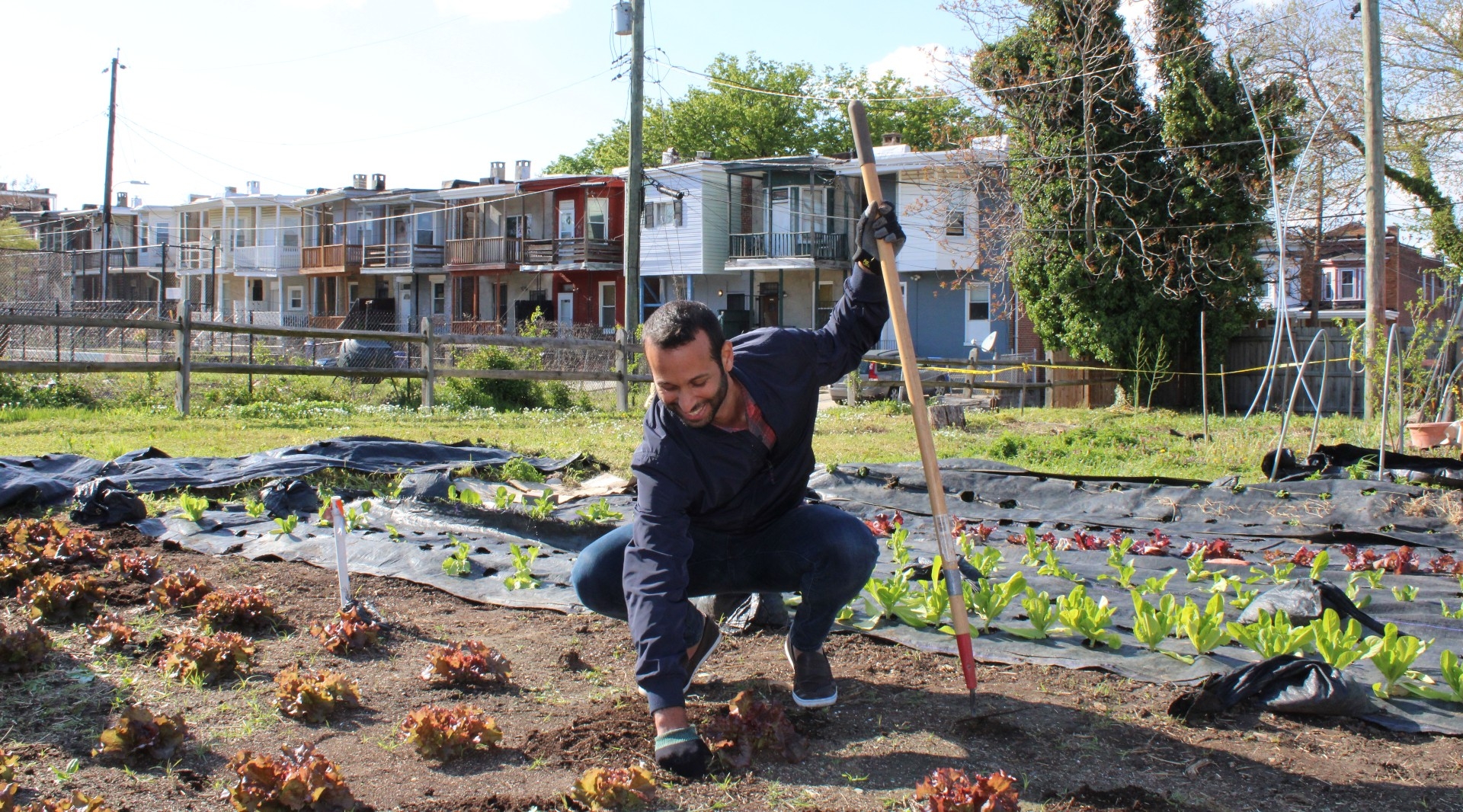
Janu Mendel, the Southeast regional director of Repair the World, tends to vegetation at a local community farm in Miami. (Courtesy of Repair the World)
Greenberg said expanding the Jewish service movement will lead to a flourishing Jewish community and strengthen society generally.
Repair the World was founded 13 years ago to make service a defining element of Jewish life. Since then, studies have shown that Jewish young adults increasingly express their Jewish identity by caring for the vulnerable.
“Over 13 years, Repair the World has been the driving force of the Jewish service movement, ensuring that these experiences are grounded in serious Jewish learning,” said Barry Finestone, president and CEO of the Jim Joseph Foundation, one of Repair’s funders. “Repairs organizational partnerships, fellowship programs, and proven best practices define the movement today — and enable so many to find purpose in Jewish life while creating change.”
While most of those who serve with Repair — about three quarters — are Jewish, much of the impact is in non-Jewish communities. About eight years ago, for example, the organization began partnering with St. John’s Bread and Life, a faith-based emergency food provider in Brooklyn that operates a food pantry, serves hot meals and hosts a mobile kitchen.
St. John’s serves approximately 1,000 hot meals a day, according to Sister Marie Sorenson, the chaplain there. The current Repair the World fellow serving with St. John’s has continued volunteer outreach, ensuring that unhoused and food-insecure individuals and families in the neighborhood have their nutritional needs met with compassion and respect. Repair also has organized volunteers to give thousands of toiletries, personal hygiene kits, baby wipes, diapers and baby formula to clients of St. John’s.
“Because we are both faith-based service organizations, we have really connected well with each other,” Sorenson said.
This commitment to food justice is connected to Repair’s service impact nationwide. Repair has mobilized volunteers to donate 200,000 pounds of food and prepared or served more than 100,000 meals to people in need throughout the country.
In the partnership with St. John’s, the Christian participants tend to be locals who have extra time or are retirees, whereas the Repair volunteers are “young people who value service, who value giving back to the community,” Sorenson noted.
Repair is funded by a wide array of supporters, including Jewish federations across the country, the Jim Joseph Foundation, and the Charles and Lynn Schusterman Family Philanthropies. Repair’s expansive pandemic response, Serve the Moment, drew funding from philanthropist MacKenzie Scott and the Jewish Communal Response and Impact Fund, known as JCRIF.
Repair has also invested significantly in partnerships with other Jewish organizations to maximize reach and impact.
“The power of Repair’s model is the opportunity it provides for young adult volunteers to learn from and work in deep partnership with the communities they are serving — while engaging in Jewish life and learning,” said Lisa Eisen, Repair’s founding board chair and co-president of Schusterman Family Philanthropies. “We saw this so clearly through the pandemic, when Repair mobilized tens of thousands of young Jews to support people in need while also providing an avenue for them to stay connected to each other and Jewish community.”
Eric Fingerhut, the president and CEO of the Jewish Federations of North America, described service programs as a gateway to greater Jewish involvement. “We believe service is a powerful tool for expanding engagement in Jewish life across the system,” Fingerhut said.
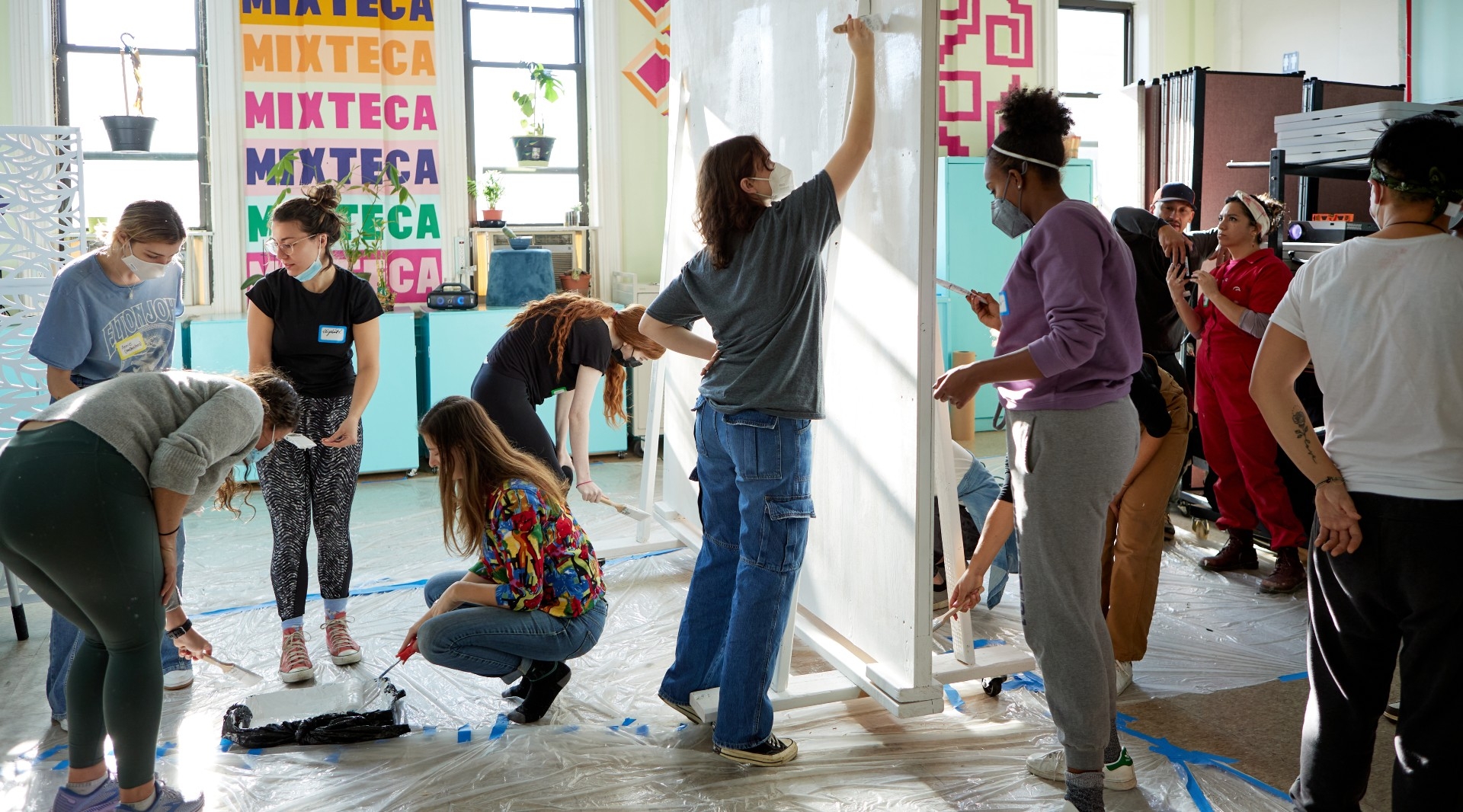
Volunteers paint and restore a community space during MLK Weekend of service in New York. (Shulamit Photo + Video)
Lippitt, Repair’s board chair, noted that Repair’s service work is especially important given the divisions in the country right now.
“It’s a vitally important bridge-building experience with our neighbors in these divided times,” he said. “The benefits that come at this moment in American history of getting out in the community and serving alongside people who may not see the world as you do are just immense for the community and for society.”
Many of the young Jews who work with Repair the World come from cohorts that traditional Jewish organizations have struggled to reach. In the most recent data collected by the organization, Repair found that between 19 and 25% of participants identify as having a disability; 25% of participants and 44% of corps members identify as non-white; and 75% of fellows, 42% of corps members, and 22% of participants identify as LGBTQ.
After Jon Cohen finished his yearlong fellowship with Repair, he went to medical school as planned, but he soon realized it wasn’t the path he wanted. When an opportunity came up to join Repair’s staff in Miami, he jumped at the opportunity, staying for three years. He now is the director of community mobilization at Keshet, the Jewish LGBTQ+ rights organization, and serves on Repair’s board of directors.
“Service has always been something that was important to me but never existed through Judaism until I did the fellowship,” Cohen said of his experience. “It was groundbreaking for me to learn about tikkun olam and all of my Jewish values. It was such an educational experience, and now I feel so proudly and passionately Jewish because of the foundation Repair the World gave me.”
In speech to EU parliament, Israel’s president says criticism is OK, but questioning Israel’s existence is not
(JTA) — In a speech to the European Union parliament tied to commemorating International Holocaust Remembrance Day, Israeli President Isaac Herzog said that criticism of his country, which has drawn renewed international scrutiny over its new right-wing government, is legitimate. Questioning Israel’s right to exist, he added, is “antisemitism in the full sense of the word.”
“It is, of course, OK to criticize the state that I head. It is OK to criticize us, and it is OK to disagree with us, just as it is OK to criticize you and your states,” he said on Thursday. “Our country is open to criticism like all members in the family of nations, and Israeli democracy certainly excels in fierce and penetrating internal criticism.”
Herzog’s comments come as his government back home has proposed a wave of judicial reforms that critics say will damage Israel’s standing as a full-fledged democracy. Two Israeli tech firms pulled their funds out of the country on the same day, citing what they deem the financial dangers of the government’s proposals, and all eyes are fixed on the government’s right-wing Cabinet ministers in charge of security and the West Bank after a military raid left nine Palestinians dead on Thursday.
Later in the day, Herzog visited a Jewish school in Brussels, where he was asked a question about the government’s controversial proposals.
“In the current crisis in Israel,” he responded, according to the Times of Israel. “I am making a supreme effort to create a dialogue between all sides. This is an important presidential role, to try and do good for the people of Israel.”
On Tuesday, Herzog, a former Labor Party leader, sharply criticized the judicial reform proposals, which would strip the country’s Supreme Court of the power to override parliament decisions.
“The dramatic reform, when done quickly without negotiation, rouses opposition and deep concerns among the public,” he said, according to the Times of Israel. “I see the sides prepared and ready all along the front for an all-out confrontation over the character of the State of Israel, and I am anxious we are on the brink of an internal struggle that could consume us all.”
Herzog’s EU speech also comes at a time when recent surveys of views in European countries, such as a recent one conducted in Belgium’s neighbor the Netherlands, show record levels of Holocaust ignorance and acceptance of antisemitic beliefs.
“I call upon you, elected officials of Europe, do not stand by, you must read the warning signs and fight at all costs,” he said. “You must ensure that every Jew wanting to live a full Jewish life in your countries may do so safely and fearlessly.”
Friday marks International Holocaust Remembrance Day, tied to the anniversary of the liberation of the Auschwitz-Birkenau concentration camp. Herzog also mentioned his family history in his remarks, wore a kippah at the podium and recited a version of “El Malei Rachamim,” a traditional Jewish prayer for the dead that had been rewritten by his grandfather — Rabbi Isaac Herzog, Israel’s first chief rabbi — to account for enormity of the Holocaust.
“In the only Jewish synagogue in Warsaw that was still standing [after the Holocaust], the Nozhik synagogue, a few dozen souls gathered, snatched from the jaws of carnage. A blood stained Torah scroll was handed to my grandfather by the survivors to be taken to the land of Israel for internal memory,” he said.
Germany’s liberal rabbinical association expels rabbi at center of sweeping scandal
BERLIN (JTA) – The embattled Rabbi Walter Homolka, accused of abuse of power at the liberal rabbinical seminary he founded, has suffered yet another consequence: expulsion from Germany’s liberal rabbinical association.
The expulsion does not affect any work that Homolka might do as a rabbi or professor in Germany or beyond. But it strips him of a role in determining whether new rabbis are admitted to the group and in weighing in on actions that the group takes collectively — a substantial setback for a man responsible for the birth and growth of many of Germany’s non-Orthodox Jewish institutions.
The vote took place Wednesday at the Berlin headquarters of the Central Council of Jews in Germany. There, members of the General Rabbinical Conference, known as ARK, voted 19 to 8 to expel Homolka, according to a statement from the group’s leadership, which said the vote took place “at the request of some members.” Homolka was not present.
The vote achieved the two-thirds majority required to pass but also revealed that Homolka continues to have substantial support despite two separate investigations finding in recent months that he created an “atmosphere of fear” among staff and students at the liberal Abraham Geiger College and other Jewish educational institutions he founded.
According to attendees, the vote followed a presentation by Central Council executive director Daniel Botmann, who reportedly outlined the findings of the two investigations – one by the University of Potsdam, which hosts two rabbinical schools that Homolka started and where he had been on the faculty, and the other commissioned by the Central Council itself.
Botmann was not present during the official ARK meeting where the vote was taken. Rabbi Andreas Nachama, chair of the liberal rabbinical group, told the Jewish Telegraphic Agency that the vote took place without any further discussion.
The final report from the law firm commissioned by the Central Council, potentially containing new details, is expected to be released in the coming weeks. Homolka has firmly denied accusations of abuse of power since they first broke into public view last May. But he has lost or given up roles in a number of German Jewish organizations nonetheless.
At the same meeting, the ARK accepted into its ranks two recently ordained rabbis from the Geiger College and the conservative Zacharias Frankel College, both housed at the University of Potsdam. Homolka was the founder and rector of Geiger College but ceded it earlier this month to the Jewish Community of Berlin, which assured the Central Council that Homolka would no longer play any role there.
Militant groups vow to retaliate after major Israeli raid in Jenin kills 9 Palestinians
(JTA) — At least nine Palestinians were killed in Jenin during the first major Israeli raid on the city since Israel’s new right-wing government took office last month.
Israeli authorities say they killed six militants in the raid Thursday on what they said was a safe house. They said the raid was aimed at heading off a major attack on Israel.
Palestinian officials said nine were killed, including civilians, among them a 60-year-old woman, and that Israeli forces blocked entry to first responders for hours.
Palestinian Authority President Mahmoud Abbas declared three days of mourning and Hamas and Islamic Jihad, Islamist terrorists whose affiliates are among the armed gangs who effectively control the city, vowed to retaliate.
The raid, the largest in months, comes as the new Israeli government led by Prime Minister Benjamin Netanyahu, the most right-wing in history, is in its first weeks. Before he stepped down earlier this month, the previous head of the Israel Defense Forces warned that the coalition’s plans, especially around governance in the West Bank, could ignite conflict and make Israelis less safe.
The raid also comes a week ahead of a visit to the region by U.S. Secretary of State Antony Blinken. The Biden administration, focused on supporting Ukraine’s effort to repel Russia’s invasion, is seeking quiet in the Middle East. Also at stake are pledges by Blinken and Netanyahu to expand the Abraham Accords, Israel’s normalization agreements with four Arab countries.
Israel has been targeting Jenin since last April, after a series of deadly attacks on Israeli civilian targets inside Israel’s pre-1967 borders, and in the West Bank. Israeli authorities say the attacks originate in the West Bank city, which is nominally under Palestinian Authority control, but where militias reign.








